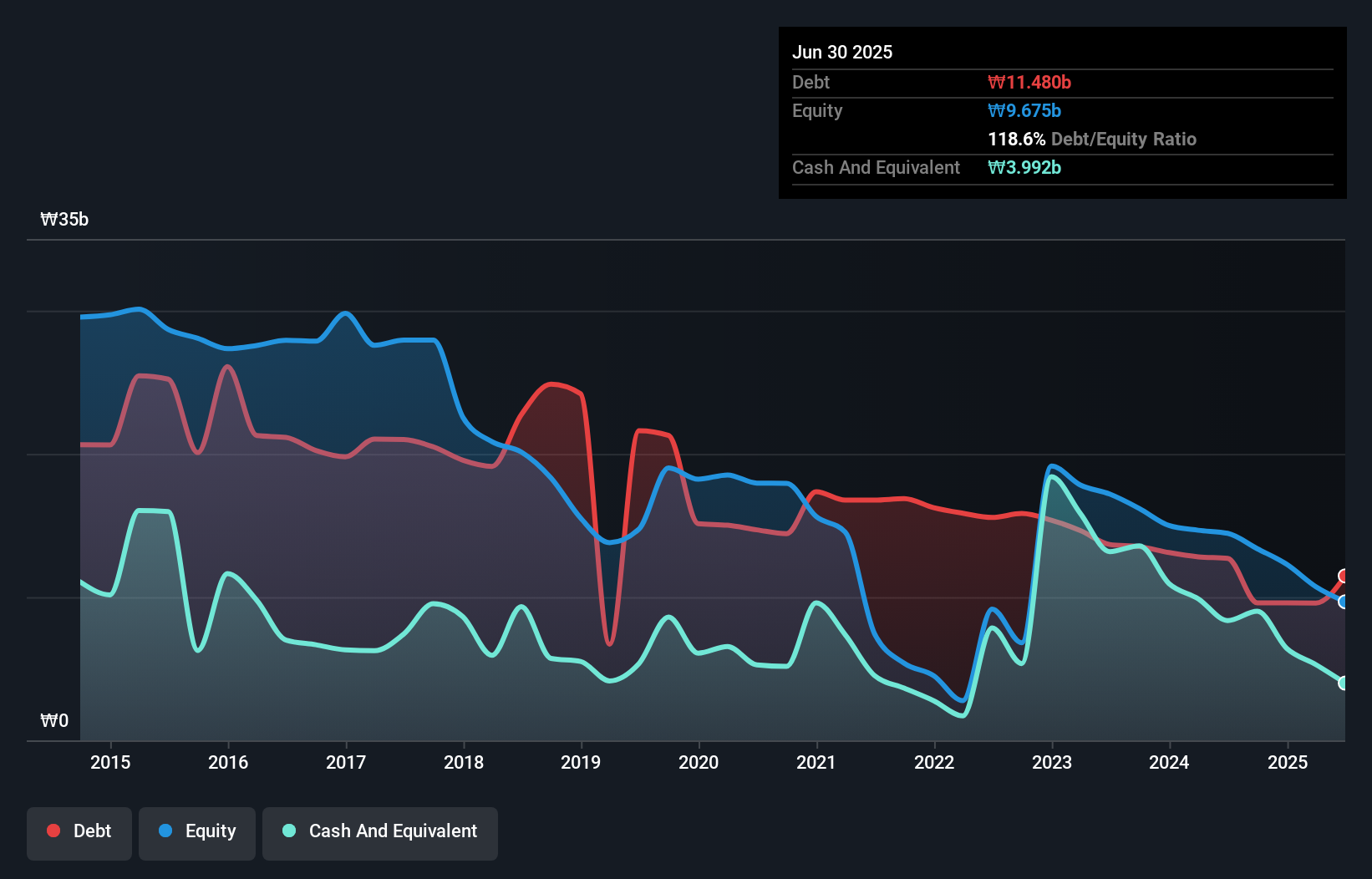Some say volatility, rather than debt, is the best way to think about risk as an investor, but Warren Buffett famously said that 'Volatility is far from synonymous with risk.' When we think about how risky a company is, we always like to look at its use of debt, since debt overload can lead to ruin. Importantly, KOYJ Co., Ltd. (KOSDAQ:121850) does carry debt. But the more important question is: how much risk is that debt creating?
When Is Debt A Problem?
Generally speaking, debt only becomes a real problem when a company can't easily pay it off, either by raising capital or with its own cash flow. Part and parcel of capitalism is the process of 'creative destruction' where failed businesses are mercilessly liquidated by their bankers. However, a more frequent (but still costly) occurrence is where a company must issue shares at bargain-basement prices, permanently diluting shareholders, just to shore up its balance sheet. Of course, the upside of debt is that it often represents cheap capital, especially when it replaces dilution in a company with the ability to reinvest at high rates of return. The first thing to do when considering how much debt a business uses is to look at its cash and debt together.
What Is KOYJ's Debt?
You can click the graphic below for the historical numbers, but it shows that KOYJ had ₩11.5b of debt in June 2025, down from ₩12.7b, one year before. However, it does have ₩3.99b in cash offsetting this, leading to net debt of about ₩7.49b.

How Strong Is KOYJ's Balance Sheet?
We can see from the most recent balance sheet that KOYJ had liabilities of ₩14.3b falling due within a year, and liabilities of ₩3.84b due beyond that. Offsetting these obligations, it had cash of ₩3.99b as well as receivables valued at ₩4.83b due within 12 months. So it has liabilities totalling ₩9.30b more than its cash and near-term receivables, combined.
This deficit isn't so bad because KOYJ is worth ₩19.7b, and thus could probably raise enough capital to shore up its balance sheet, if the need arose. But it's clear that we should definitely closely examine whether it can manage its debt without dilution. There's no doubt that we learn most about debt from the balance sheet. But you can't view debt in total isolation; since KOYJ will need earnings to service that debt. So when considering debt, it's definitely worth looking at the earnings trend. Click here for an interactive snapshot.
See our latest analysis for KOYJ
In the last year KOYJ had a loss before interest and tax, and actually shrunk its revenue by 3.4%, to ₩19b. We would much prefer see growth.
Caveat Emptor
Over the last twelve months KOYJ produced an earnings before interest and tax (EBIT) loss. Indeed, it lost a very considerable ₩4.5b at the EBIT level. When we look at that and recall the liabilities on its balance sheet, relative to cash, it seems unwise to us for the company to have any debt. So we think its balance sheet is a little strained, though not beyond repair. Another cause for caution is that is bled ₩6.3b in negative free cash flow over the last twelve months. So in short it's a really risky stock. When analysing debt levels, the balance sheet is the obvious place to start. But ultimately, every company can contain risks that exist outside of the balance sheet. We've identified 2 warning signs with KOYJ (at least 1 which is a bit concerning) , and understanding them should be part of your investment process.
At the end of the day, it's often better to focus on companies that are free from net debt. You can access our special list of such companies (all with a track record of profit growth). It's free.
Valuation is complex, but we're here to simplify it.
Discover if KOYJ might be undervalued or overvalued with our detailed analysis, featuring fair value estimates, potential risks, dividends, insider trades, and its financial condition.
Access Free AnalysisHave feedback on this article? Concerned about the content? Get in touch with us directly. Alternatively, email editorial-team (at) simplywallst.com.
This article by Simply Wall St is general in nature. We provide commentary based on historical data and analyst forecasts only using an unbiased methodology and our articles are not intended to be financial advice. It does not constitute a recommendation to buy or sell any stock, and does not take account of your objectives, or your financial situation. We aim to bring you long-term focused analysis driven by fundamental data. Note that our analysis may not factor in the latest price-sensitive company announcements or qualitative material. Simply Wall St has no position in any stocks mentioned.
About KOSDAQ:A121850
KOYJ
Engages in the manufacture and sale of composite optical films and materials in South Korea.
Very low risk with worrying balance sheet.
Market Insights
Community Narratives




